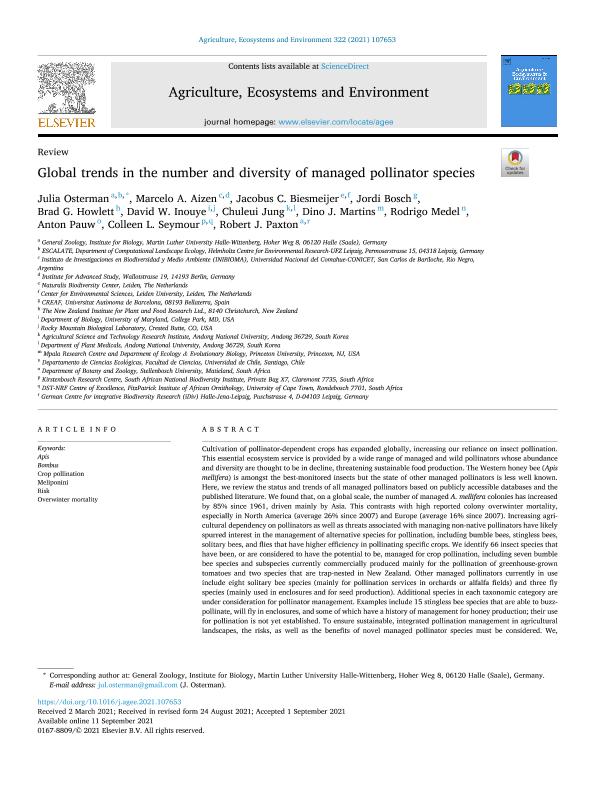Artículo
Global trends in the number and diversity of managed pollinator species
Osterman, Julia; Aizen, Marcelo Adrian ; Biesmeijer, Jacobus C.; Bosch, Jordi; Howlett, Brad G.; Inouye, David W.; Jung, Chuleui; Martins, Dino J.; Medel, Rodrigo; Pauw, Anton; Seymour, Colleen L.; Paxton, Robert J
; Biesmeijer, Jacobus C.; Bosch, Jordi; Howlett, Brad G.; Inouye, David W.; Jung, Chuleui; Martins, Dino J.; Medel, Rodrigo; Pauw, Anton; Seymour, Colleen L.; Paxton, Robert J
 ; Biesmeijer, Jacobus C.; Bosch, Jordi; Howlett, Brad G.; Inouye, David W.; Jung, Chuleui; Martins, Dino J.; Medel, Rodrigo; Pauw, Anton; Seymour, Colleen L.; Paxton, Robert J
; Biesmeijer, Jacobus C.; Bosch, Jordi; Howlett, Brad G.; Inouye, David W.; Jung, Chuleui; Martins, Dino J.; Medel, Rodrigo; Pauw, Anton; Seymour, Colleen L.; Paxton, Robert J
Fecha de publicación:
12/2021
Editorial:
Elsevier Science
Revista:
Agriculture, Ecosystems and Environment
ISSN:
0167-8809
Idioma:
Inglés
Tipo de recurso:
Artículo publicado
Clasificación temática:
Resumen
Cultivation of pollinator-dependent crops has expanded globally, increasing our reliance on insect pollination. This essential ecosystem service is provided by a wide range of managed and wild pollinators whose abundance and diversity are thought to be in decline, threatening sustainable food production. The Western honey bee (Apis mellifera) is amongst the best-monitored insects but the state of other managed pollinators is less well known. Here, we review the status and trends of all managed pollinators based on publicly accessible databases and the published literature. We found that, on a global scale, the number of managed A. mellifera colonies has increased by 85% since 1961, driven mainly by Asia. This contrasts with high reported colony overwinter mortality, especially in North America (average 26% since 2007) and Europe (average 16% since 2007). Increasing agricultural dependency on pollinators as well as threats associated with managing non-native pollinators have likely spurred interest in the management of alternative species for pollination, including bumble bees, stingless bees, solitary bees, and flies that have higher efficiency in pollinating specific crops. We identify 66 insect species that have been, or are considered to have the potential to be, managed for crop pollination, including seven bumble bee species and subspecies currently commercially produced mainly for the pollination of greenhouse-grown tomatoes and two species that are trap-nested in New Zealand. Other managed pollinators currently in use include eight solitary bee species (mainly for pollination services in orchards or alfalfa fields) and three fly species (mainly used in enclosures and for seed production). Additional species in each taxonomic category are under consideration for pollinator management. Examples include 15 stingless bee species that are able to buzz-pollinate, will fly in enclosures, and some of which have a history of management for honey production; their use for pollination is not yet established. To ensure sustainable, integrated pollination management in agricultural landscapes, the risks, as well as the benefits of novel managed pollinator species must be considered. We, therefore, urge the prioritization of biodiversity-friendly measures maintaining native pollinator species diversity to provide ecosystem resilience to future environmental changes.
Palabras clave:
APIS
,
BOMBUS
,
CROP POLLINATION
,
MELIPONINI
,
OVERWINTER MORTALITY
,
RISK
Archivos asociados
Licencia
Identificadores
Colecciones
Articulos(INIBIOMA)
Articulos de INST. DE INVEST.EN BIODIVERSIDAD Y MEDIOAMBIENTE
Articulos de INST. DE INVEST.EN BIODIVERSIDAD Y MEDIOAMBIENTE
Citación
Osterman, Julia; Aizen, Marcelo Adrian; Biesmeijer, Jacobus C.; Bosch, Jordi; Howlett, Brad G.; et al.; Global trends in the number and diversity of managed pollinator species; Elsevier Science; Agriculture, Ecosystems and Environment; 322; 107653; 12-2021; 1-13
Compartir
Altmétricas



